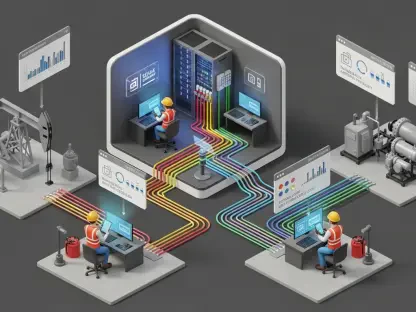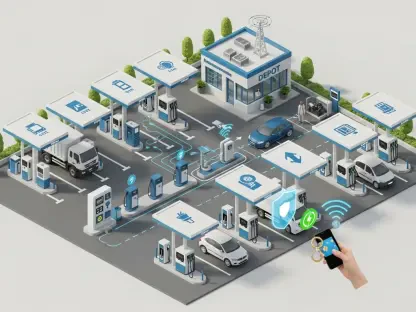The rapid ascent of Artificial Intelligence (AI) is transforming the technological landscape at an astonishing pace, but it’s also unleashing a hidden crisis that threatens to destabilize the very foundation of modern infrastructure in the United States. Across the nation, the voracious energy appetite of AI data centers is surging, consuming electricity at levels previously unimaginable and placing unprecedented stress on an aging power grid that was never designed for such demands. This isn’t merely a challenge for tech companies—it’s a national issue with far-reaching implications for energy stability, economic competitiveness, and environmental goals. From bustling tech corridors to remote energy hubs, the clash between cutting-edge innovation and outdated systems is becoming impossible to ignore. As AI continues to drive progress, the question looms: can the country’s energy infrastructure keep pace with this relentless growth, or will it buckle under the pressure of a digital revolution?
AI’s Growing Energy Appetite
The Scale of Demand
The sheer magnitude of energy consumption tied to AI data centers is nothing short of staggering, painting a vivid picture of a technology boom with profound real-world consequences. Current estimates suggest that by the end of this year, these facilities will account for 23 gigawatts of power usage in the U.S. alone—an amount equivalent to twice the total electricity consumption of a nation like the Netherlands. This isn’t a fleeting spike but a sustained trend, with projections indicating that by 2028, data centers could claim between 6.7% and 12% of the country’s entire electricity output. Such numbers underscore a seismic shift in how energy is allocated, driven by the computational intensity of AI workloads that power everything from machine learning algorithms to generative models. The scale of this demand is reshaping priorities, forcing utilities and policymakers to grapple with a reality where digital innovation directly competes with traditional energy needs.
Beyond the raw numbers, the specifics of AI hardware reveal why this hunger for power is so acute and challenging to manage, especially as technology continues to evolve at a rapid pace. By 2027, server racks in data centers are expected to require up to 176 kilowatts per square foot—a dramatic leap from previous generations of technology that operated on far less. Cooling systems, essential to prevent overheating of these high-density setups, add another layer of strain by consuming millions of gallons of water daily, particularly in regions already facing scarcity. A single 100-megawatt data center can match the electricity usage of 75,000 homes, illustrating how these facilities are not just tech hubs but energy behemoths. This dual demand for power and water amplifies the pressure on local resources, creating a complex puzzle that extends well beyond the walls of any single server farm.
Historical Context and Future Projections
Looking at the trajectory of energy demand over recent years highlights just how unprecedented the current situation is compared to past patterns, with data center electricity consumption in the U.S. skyrocketing by 80% between 2020 and the present. This sharp departure from the relatively flat demand seen in the two decades prior reflects not only the rise of AI but also broader trends like electrification and manufacturing growth. However, the grid—much of which is over 25 years old—was built for a different era, one where steady, predictable loads dominated rather than the constant, high-capacity needs of modern technology. This mismatch between historical infrastructure and today’s requirements is a critical barrier, exposing vulnerabilities that could disrupt everything from daily operations to long-term planning.
As attention shifts to the future, the outlook only intensifies the urgency of addressing these challenges before they spiral further out of control. By 2030, data centers are projected to consume more electricity than energy-intensive industries like steel and cement combined, potentially reaching upwards of 580 terawatt-hours annually in the U.S. alone. This forecast positions AI not just as a driver of innovation but as a transformative force akin to past industrial revolutions, where energy access defined progress. If unchecked, this growth could overwhelm existing systems, leading to widespread instability. The stakes are clear: adapting to this new normal demands a fundamental rethinking of how energy is generated, transmitted, and consumed in a world increasingly shaped by digital demands.
Strain on the U.S. Power Grid
Aging Infrastructure Challenges
The foundation of the U.S. power grid, largely constructed decades ago, is proving woefully inadequate for the relentless energy demands imposed by AI data centers, which require continuous and high-density power loads unlike the predictable, moderate patterns of the past. Much of this infrastructure exceeds 25 years in age, designed for a different era of electricity consumption. The result is a system under siege, struggling to maintain stability as data centers draw power at levels that rival entire cities. Grid bottlenecks and limited transmission capacity exacerbate the issue, raising serious concerns about potential blackouts and outages. As these facilities cluster in key regions, the risk of localized failures grows, threatening not just tech operations but the broader reliability of electricity for households and businesses alike.
Compounding the problem is the ripple effect of this strain on everyday Americans, who may bear the brunt of an overburdened system through escalating costs and diminished service quality. With overall electricity demand projected to rise by 9% by 2028 and 18% by 2033—driven by AI alongside electrification and electric vehicles—the financial burden of modernizing the grid could fall on consumers. Utilities, already stretched thin, face the daunting task of balancing these unprecedented needs with the risk of passing on higher bills. Globally, while other nations face similar tech-driven energy challenges, the U.S. stands out due to its aging infrastructure and regional disparities, making the situation particularly acute. Without swift intervention, the gap between capacity and demand risks widening, with far-reaching consequences for economic stability and quality of life.
Supply Chain and Upgrade Delays
Beyond the physical limitations of the grid itself, the process of upgrading infrastructure is mired in delays that further hinder efforts to keep pace with AI’s energy needs, creating a critical challenge for the industry. Supply chain bottlenecks for critical equipment, such as transformers, often result in lead times of 18 to 24 months, stalling projects that are already urgent. These delays are not mere inconveniences but significant roadblocks, as new power generation and transmission projects can take a decade or more to complete due to regulatory hurdles and logistical challenges. In a landscape where data center demand is growing exponentially, such timelines are unsustainable, leaving utilities and tech companies scrambling to find stopgap measures while long-term solutions remain out of reach.
The impact of these delays extends into the broader strategy for grid modernization, creating a vicious cycle of deferred progress and mounting pressure that hinders overall development. Interconnection queues for new energy projects have ballooned, with some regions reporting increases of up to 700% as developers wait for approval to connect to the grid. This backlog not only slows the integration of cleaner, more efficient power sources but also perpetuates reliance on outdated systems that are ill-suited for current demands. The urgency to streamline these processes is palpable, as every month of delay translates into greater strain on existing resources. Addressing these supply chain and procedural bottlenecks is essential if the energy sector hopes to match the speed of technological advancement driving this crisis.
West Texas Gas Bottleneck
Resource Abundance vs. Infrastructure Lag
In the heart of West Texas, the Permian Basin stands as one of the most prolific natural gas-producing regions in the U.S., holding vast reserves that could theoretically alleviate much of the energy pressure from AI data centers. Yet, despite this abundance, a severe infrastructure lag prevents these resources from being effectively harnessed. Insufficient pipelines and conversion facilities mean that much of the gas remains trapped or underutilized, unable to be transformed into the electricity needed to power tech hubs across the country. This bottleneck is a stark illustration of a broader national challenge: having the raw materials is not enough if the systems to deliver them are lacking. The frustration is palpable as energy that could fuel progress sits idle, exacerbating an already strained power grid.
This disconnect between resource wealth and practical access is not just a missed opportunity but a critical barrier to meeting soaring demand, especially as energy needs continue to grow. In some instances, the oversupply of gas in West Texas has led to negative prices, where producers essentially pay to have their product taken away due to the inability to transport or store it effectively. Such economic inefficiencies highlight the urgency of addressing infrastructure gaps, as wasted resources translate into lost potential for stabilizing national energy supplies. The situation in this region serves as a microcosm of larger systemic issues, where the promise of abundant energy clashes with the reality of outdated or incomplete delivery mechanisms. Bridging this gap requires investment and innovation at a scale that matches the enormity of the challenge posed by AI’s growth.
Economic and Regional Impacts
The infrastructure shortfall in West Texas doesn’t just hinder energy supply—it also inflicts significant economic repercussions that ripple through local communities and beyond, creating a challenging landscape for many stakeholders. Small gas producers in the region, lacking the capital or connections to build necessary pipelines, often find themselves sidelined, unable to capitalize on the AI-driven demand boom. This creates a divide between larger corporations that can adapt and smaller entities that risk financial strain or obsolescence. The wasted gas, sometimes flared off due to a lack of transport options, represents not only lost revenue but also an environmental cost, further complicating the narrative of energy abundance. For the local economy, this bottleneck stifles growth and limits job creation in a sector that could otherwise thrive.
Nationally, the effects of this regional bottleneck contribute to broader supply chain vulnerabilities, impacting the ability to meet AI energy needs in tech-heavy areas far from Texas. The inefficiency drives up costs for utilities and tech companies reliant on natural gas as a bridge fuel, potentially leading to higher electricity prices that affect consumers across the board. Additionally, the disparity in infrastructure readiness between regions like West Texas and high-demand zones highlights a growing inequity in energy access. Communities in the Permian Basin bear the burden of underinvestment, while distant urban centers feel the downstream effects of supply shortages. Resolving these regional disparities is crucial to ensuring that the benefits of energy resources are equitably distributed and effectively utilized to support technological progress.
Market and Policy Responses
Corporate Strategies and Opportunities
As the energy demands of AI data centers escalate, major tech companies are not sitting idly by but are instead taking proactive steps to secure reliable power sources, reshaping the energy landscape in the process. Hyperscalers like Google, Microsoft, and Amazon are investing heavily in alternative solutions, from nuclear Small Modular Reactors (SMRs) to expansive renewable energy projects. A notable example is Microsoft’s partnership with Constellation Energy to restart the Three Mile Island nuclear plant, signaling a bold move toward dedicated, sustainable power. These initiatives reflect a broader trend where tech giants are evolving from mere consumers of energy into active players in its production, driven by the need to ensure uptime for their data-intensive operations. Such strategies, while innovative, require significant time and capital, underscoring the long-term nature of the challenge.
Meanwhile, this crisis is carving out distinct opportunities for sectors poised to adapt swiftly to shifting demands, creating a landscape where quick response and innovation are paramount for success. Natural gas producers like EQT Corporation, equipment manufacturers such as GE Vernova, and utilities including Dominion Energy stand to gain as the need for power generation and grid upgrades intensifies. Companies that can deliver scalable solutions or modernize infrastructure are likely to see substantial growth, capitalizing on a market hungry for stability. Conversely, smaller entities or those tethered to outdated systems risk falling behind, unable to meet the pace of change. This dynamic creates a clear divide between winners and losers, where agility and foresight become critical competitive advantages in navigating the intersection of technology and energy.
Government Action and Urgency
Recognizing the gravity of the energy crisis fueled by AI, governmental bodies at both federal and state levels are mobilizing with a sense of urgency to safeguard grid reliability and accelerate infrastructure development. Recent executive actions have prioritized streamlining permitting processes for large-scale grid projects, with initiatives like the Department of Energy’s “Speed to Power” program aiming to cut through bureaucratic delays. Emergency declarations underscore the national stakes, framing energy stability as a cornerstone of economic and technological leadership. States, meanwhile, are competing to attract data center investments by offering incentives tied to energy readiness, creating a competitive landscape where policy innovation is as critical as technological advancement. These efforts signal a growing awareness that the energy challenge is inseparable from broader strategic goals.
Collaboration between public and private sectors is emerging as a linchpin in addressing these systemic issues, though progress remains uneven across regions. Partnerships involving tech companies, utilities, and government agencies are fostering dialogue on transparency in energy and water usage, informing smarter policy decisions. However, disparities in infrastructure readiness and regulatory frameworks mean that some areas are better positioned to benefit from these initiatives than others. The push for rapid action must contend with the complexity of aligning diverse stakeholders, each with distinct priorities and constraints. Nevertheless, the momentum behind these coordinated responses highlights a collective recognition that without decisive intervention, the energy demands of AI could outstrip the nation’s capacity to support them, jeopardizing future growth.
Environmental and Social Implications
Sustainability Concerns
The escalating reliance on natural gas to meet the energy needs of AI data centers raises significant environmental concerns that cannot be overlooked amidst the push for technological advancement. While natural gas serves as a flexible and relatively accessible bridge fuel, its carbon emissions conflict with national and global decarbonization targets, complicating efforts to mitigate climate change. The urgency to power data centers often prioritizes immediate availability over long-term sustainability, creating a tension that challenges policymakers and corporations alike. Balancing the need for reliable energy with the imperative to reduce greenhouse gas emissions remains a formidable obstacle, especially as demand projections continue to climb. Addressing this issue requires not just temporary fixes but a strategic shift toward cleaner alternatives that can scale effectively.
Another pressing issue tied to data center operations is the immense water consumption required for cooling systems, particularly in arid regions where resources are already scarce, and this demand places a significant burden on local environments. Millions of gallons are used daily to prevent overheating of high-density AI hardware, adding further strain on ecosystems and communities facing drought conditions. This environmental footprint extends the impact of AI beyond energy grids into broader resource management debates, highlighting the need for innovative cooling technologies or site selection strategies that minimize water use. The intersection of power and water challenges underscores a critical reality: the growth of AI must be paired with sustainable practices to avoid exacerbating existing ecological pressures, a task that demands both technological ingenuity and policy foresight.
Impact on Communities and Costs
The strain on energy infrastructure driven by AI is not an abstract issue confined to boardrooms or server farms—it has tangible consequences for everyday Americans who may face rising electricity costs as a direct result. Upgrading the grid and expanding capacity to meet data center demands involve substantial investments, often in the billions, and these expenses are frequently passed on to consumers through higher bills. For households already grappling with economic pressures, this added burden can be significant, amplifying concerns about affordability and equity in access to essential services. The potential for cost increases also affects non-tech industries, which may struggle to compete for power in a market increasingly dominated by digital giants, further widening economic disparities.
Access to reliable and affordable power is emerging as a key determinant of regional economic competitiveness, significantly influencing where tech investments flow and how communities benefit from the AI boom. Areas with robust energy infrastructure stand to attract data center projects, bringing jobs and development, while regions lagging behind risk being overlooked. This dynamic creates a stark divide, where the ability to solve energy challenges becomes a competitive edge with lasting implications for local economies. The social impact of this crisis thus extends beyond immediate financial concerns to shape the geographic distribution of opportunity, emphasizing the need for balanced investment that ensures no community is left behind in the race to support technological progress.
Powering the Digital Future
The unfolding saga of AI’s impact on the U.S. energy landscape revealed a profound challenge that demanded urgent and innovative responses from all corners of society, as the staggering growth in data center energy consumption had placed immense pressure on an outdated power grid. Bottlenecks in regions like West Texas exposed critical weaknesses in the natural gas supply chain. Corporate giants and nimble energy firms had begun to carve out paths forward through investments in nuclear and renewable solutions, while government actions aimed to fast-track infrastructure projects underscored the national stakes. Environmental and social concerns, from carbon emissions to rising consumer costs, had added layers of complexity to an already daunting puzzle. Reflecting on these developments, it became evident that the intersection of technology and energy had reached a pivotal moment, one that required not just adaptation but a reimagining of systems built for a different era.
Moving ahead, the focus must shift to actionable strategies that bridge the gap between AI’s relentless needs and the capacity of current infrastructure, ensuring a sustainable path forward. Accelerating investments in grid modernization and diversified energy sources—spanning renewables, nuclear, and efficient gas use—stands as a priority to ensure stability. Policymakers should continue fostering public-private collaborations to streamline project timelines and enhance transparency in resource usage, while incentivizing innovations like AI-driven grid optimization. Equally important is addressing regional disparities, ensuring that areas like West Texas receive the infrastructure upgrades needed to unlock their potential. By prioritizing sustainability alongside growth and equipping communities to handle economic impacts, the nation can transform this crisis into a catalyst for a more resilient energy future, one where power truly fuels progress.









